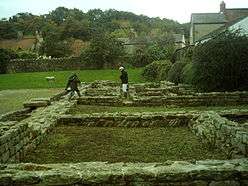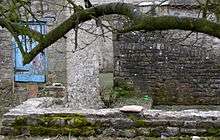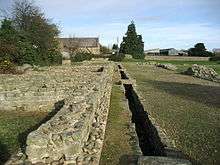Piercebridge Roman Fort
Piercebridge Roman Fort (possibly originally known as Morbium or Vinovium) is a scheduled ancient monument situated in the village of Piercebridge on the banks of the River Tees in County Durham, England. There were Romans here from about 70 AD until at least the early 5th century. There was an associated vicus and bath house at Piercebridge, and another vicus and a villa south of the river at Cliffe, Richmondshire. The Victorians used carved stones from this site when they built St Mary's church at Gainford, County Durham.[1] Part of the site is under Piercebridge village green.[1]
| Piercebridge Roman Fort | |
|---|---|
 Piercebridge Roman Fort looking south | |
 | |
| Alternative name(s) | Morbium, Vinovium |
| Founded | c. 2nd century AD |
| Abandoned | 5th or 6th century AD |
| Place in the Roman world | |
| Province | Britannia |
| Stationed military units | |
| — Legions — | |
| Location | |
| Coordinates | 54.535°N 1.678°W |
| Place name | Piercebridge |
| County | County Durham |
| Country | England |
| Reference | |
| UK-OSNG reference | NZ209156 |
| Site notes | |
| Excavation dates |
|
| Archaeologists |
|
| Exhibitions | |
 | |
| Part of a series on the | |
| Military of ancient Rome | |
|---|---|
|
|
|
| |
History
Fort
Lumps and bumps in the village green at Piercebridge indicate that underneath it is the Roman fort which was called Magis or Morbium.[1][2] Dere Street was the main road through it, or Via Principalis. It was the furthest south of four forts along Dere Street in what is now County Durham, the others being at Binchester, Lanchester and Ebchester.[3] Artefacts found in Piercebridge suggest that there were Romans on the site around the river as long ago as 70 AD, perhaps because there was a ford or ferry to be defended from the Brigantes. A civil settlement in the Toft field existed by 125 AD, and a military installation alongside Dere Street south of the Tees appeared in the late 2nd century. However the fortifications which can be seen today on the north side of the river were not built until 260 to 270 AD, when the other Roman settlements and vicus north and south of the river began to decrease in size. The fort was maintained from around 290 to 350 AD, with later development, by which time the inhabitants were mostly inside the fort area. It was inhabited until the 6th century, although some theories state that it was finally abandoned in the early 5th century.[4] It is now a scheduled ancient monument.[2] It was not the only Roman fort next to a bridge hereabouts; there was also Greta Bridge,[4] on the River Greta to the south.
Structure of fort and bridge
The fort appears to have followed the standard Roman plan, being rectangular in shape with towers at each corner and two big gates for Dere Street. Inside would be barracks, workshops, granaries and the garrison headquarters with the commandant's separate accommodation.[3] According to the 2005 Conservation Area appraisal, the bridge had a south abutment and four piers;[2] however it has been suggested by some archaeologists such as Raymond Selkirk that the existing remains do not represent a bridge, and that it is a dam and spillway.[5] If it is a Roman bridge, then it would be one of only two remaining in the country; the other one being Chesters Bridge.[1]
Vicus
To the east of the fort in Tofts Field there is a vicus which began in the 1st century AD and survived into the early 5th century:[4] a civilian settlement outside the fort's boundaries for providers of goods and services to the fort itself.[1] According to cropmarks, it apparently consisted of about thirty buildings whose inhabitants probably traded via the river from the late 1st century, but fewer people lived there once the fort's defences were built.[2] This vicus probably followed the building of the Roman villa south of the river at Holme House, which in turn began as a native roundhouse.[4] There was an associated vicus at the other side of the river crossing, at Cliffe, Richmondshire.[6][7][8]
Bath house
A Roman bath house was still standing at the south-east corner of the fort-site in the 13th century when St Mary's chapel was built to incorporate part of it: possibly the wall with rounded arched doorway which is still visible from a distance, on private land.[9] In the traditional manner, the garrison bath house stands outside the fort itself.[3] It is a Grade II* listed building and scheduled ancient monument.[2]
Archaeology

Because modern Piercebridge never extended beyond the original Roman boundaries of the fort, the north and west earthworks are preserved, and part of this has been excavated.[2] An excavation was made in 1938,[10][11] where a guard chamber each side of the western gateway was found.[12][13] They also exposed the wall of the outer rampart, near the north-west corner,[14] and in 1939 exposed part of the south outer wall.[15] Another dig was carried out by Dennis Harding and Peter Scott between 1969 and 1981.[4][16][17] A 1973 dig found a 3rd-century rectangular building with hypocaust. A bronze figure of a ploughman with oxen, which is now in the British Museum, was found here along with Roman coins dated early 4th century. St Mary's 1855 church building at Gainford contains Roman worked stones from this site.[1] Other finds have included kilns and Roman pottery, a metalworking site, a carved stone altar and burials including gravestones and a lead coffin.[18] The archaeological television programme Time Team investigated Piercebridge Roman Fort in 2009, and at that time divers examined holes in the river bed which may have been Roman.[19] Among the finds were a small lead goat and a hairpin.[20] Inscriptions found here attest to the presence of members of the Legio II Augusta, the Legio VI Victrix, and the Legio XXII Primigenia, as well as worship of Jupiter and Mars.[21] Around 1910, Edmund Wooler discovered a large, worked Roman stone which he believed to have been part of the original Roman bridge.[22][23] The site has been reassessed by archaeologist Dr David Mason in 2006, and the archive from the excavations is at the Bowes Museum.[4]
Public display
It is the eastern wall which can be seen today, with the remains of where the eastern gate was robbed out. The original rectangular defence pits are lawned over between the wall and the outer ditch.[24][25] There were obstacle pits,[26] and also man-traps or camouflaged holes spiked with large, pointed, wooden stakes for unsuspecting attackers to fall into. These were roughly square holes, probably originally covered with undergrowth.[1] Beyond the fort wall was a road with a drain or culvert which still exists.[27] The commandant's substantial house is beyond this road and built on river-pebbles.[1] He had his own bath-house, and this is the one at the north of the site on private property, but visible over a fence.[3] Admission is free and the site is open to the public all year round.[28] A large proportion of the substantial 11-acre (45,000 m2) fort now lies under later buildings; the village has never expanded beyond the old Roman boundary.[2] Visible Roman remains at the eastern part of the site include parts of the east gate and defences, a courtyard building and an internal road, and a section of the eastern elevation is now preserved and on permanent public display.[3] However it is believed that Roman residences were to the west of the revealed archaeology.[2] Some of the artefacts found at the site are on show at Bowes Museum at Barnard Castle.[29] Remains of the bridge which have carried Dere Street over the River Tees can be seen on the south side of the river at Cliffe, Richmondshire.[3]
See also
- Castra (Roman fort)
- Roman Britain
- Roman bridge
- Piercebridge
- Cliffe, Richmondshire
References
- Simpson, David (1991–2009). "Roots of the Region". Piercebridge (County Durham). Retrieved 14 January 2010.
- "Darlington.gov.uk" (PDF). Piercebridge conservation area character appraisal, consultation draft. Darlington. 2005. Retrieved 9 March 2010.
- "The Heritage Trail". Piercebridge Roman Fort & Bridge, County Durham. 1998–2010. Retrieved 12 March 2010.
- Evans, Tim (1996–2010). "ADS Archsearch". Roman Piercebridge ALSF Project Number 4698. Retrieved 9 March 2010.
- Selkirk, Raymond (2000). Chester-le-Street & Its Place in History. Birtley, County Durham: Casdec Print & Design Centre. pp. 93–122. ISBN 1-900456-05-2.
- "Heritage Gateway". Listed buildings online, and local records. Archived from the original on 25 September 2005. Retrieved 11 January 2010.
- NY SMR Number MNY12854; National Monuments Record: NZ21NW2; Grid Reference NZ 212,154, SNY8056 – Field recording Form: North Yorkshire County Council. 15 November 1994. George Hotel, Piercebridge (Dere Street Cottage). Campling, N. NYCC Observation Record
- NY SMR Number, MNY12768; National Monuments Record NZ21NW39; Grid Reference NZ 214,154; SNY1446 Unpublished document: Department of the Environment 1971 Archaeological excavations P54
- "Keys to the Past". Piercebridge, St. Mary's; site of Medieval chapel. (Piercebridge). County Durham. 2010. Retrieved 7 October 2010.
- "Durham County Council". Piercebridge, Roman Fort, excavations. DCC. 2009. Retrieved 12 March 2010.
- "Durham County Council". Piercebridge, Roman Fort, excavations. DCC. 2009. Retrieved 12 March 2010.
- "Durham County Council". Piercebridge, Roman Fort, excavations (5 September 1938). DCC. 2009. Retrieved 12 March 2010.
- "Durham County Council". Piercebridge, Roman Fort, excavations (guard chambers and western gateway, 5 September 1938). DCC. 2009. Retrieved 12 March 2010.
- "Durham County Council". Piercebridge, Roman Fort, excavations (wall of outer rampart, 5 September 1938). DCC. 2009. Retrieved 12 March 2010.
- "Durham County Council". Piercebridge, Roman Fort, excavations (outer wall looking south, 5 June 1939). DCC. 2009. Retrieved 12 March 2010.
- "Durham County Council". Piercebridge, Roman Bridge abutment. DCC. 2009. Retrieved 12 March 2010.
- "Durham County Council". Piercebridge, Roman Fort, excavations (archaeologist Peter Scott, 1975). DCC. 2009. Retrieved 12 March 2010.
- "Keys to the Past". Local History Piercebridge (County Durham). Northumberland County Council. 2010. Retrieved 7 October 2010.
- Lloyd, Chris (2 July 2009). "The Northern Echo". Piercebridge: Time Team investigates. Archived from the original on 27 September 2012. Retrieved 9 March 2010.
- "The Northern Echo". Time Team Piercebridge, near Darlington. 3 July 2009. Retrieved 9 March 2010.
- "Roman-britain.org". Roman fort & minor settlement, Piercebridge, Durham. 25 July 2006. Archived from the original on 11 April 2010. Retrieved 12 March 2010.
- "Durham County Council". Piercebridge, Edward Wooler and Roman stone. DCC. 2009. Retrieved 12 March 2010.
- "Durham County Council". Piercebridge, Roman Bridge abutment (1977). DCC. 2009. Retrieved 12 March 2010.
- "Durham County Council". Piercebridge, Roman Fort, excavations (ditch, 1938). DCC. 2009. Retrieved 12 March 2010.
- "Durham County Council". Piercebridge, Roman Fort, excavations (ditch 2, 1938). DCC. 2009. Retrieved 12 March 2010.
- "Durham County Council". Piercebridge, Roman Fort, excavations. DCC. 2009. Retrieved 12 March 2010.
- "Durham County Council". Piercebridge, Roman Fort, excavations (culvert, north-east corner, 5 September 1938). DCC. 2009. Retrieved 12 March 2010.
- "Hadrian's Wall Country". Piercebridge Roman Fort. Northumberland Tourism. 2009. Archived from the original on 5 October 2011. Retrieved 12 March 2010.
- "Brigantes Nation". Piercebridge Roman Fort. 2002. Archived from the original on 8 June 2011. Retrieved 12 March 2010.
External links
| Wikimedia Commons has media related to Piercebridge Roman fort. |
- Brigantes nation
- Roman Britain
- Photo of excavated fort
- Piercebridge Roman fort opening times
- Darlington Borough Council scheduled monuments audit 2009: section Piercebridge Roman Fort

